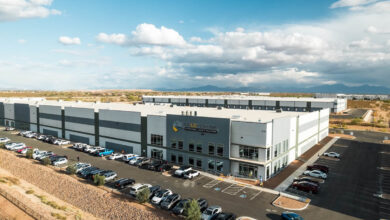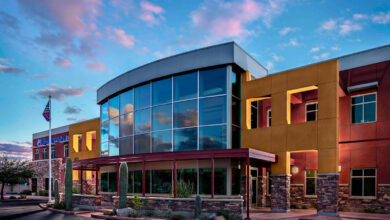
UArizona-Led Team to Develop Wearable Tech to Monitor Patient Health
The last two decades have seen an uptick in people choosing to monitor their health using wearable technologies such as Fitbits and Apple Watches. The wearable technology market is valued at $116.2 billion, and is projected to reach $265.4 billion by 2026. Some wearable devices gather not only information like calories burned and steps taken, but heart rate, blood pressure and sleeping patterns. These data points are continuously collected from users, but because they haven’t been validated at a clinical level, the data aren’t necessarily usable for medical professionals.

A multi-institution team led by University of Arizona electrical and computer engineering professor Janet Roveda is building a future in which wearable devices will allow clinicians to gather patient data remotely and provide “care in place” so patients don’t need to leave their homes. The team founded the Center to Stream Healthcare in Place, or C2SHIP, which was first selected as a National Science Foundation Industry-University Cooperative Research Center, or IUCR, in 2018 and received $15,000 in startup funding.
C2SHIP recently received a continuing NSF grant of $3 million, with $1.125 million earmarked for UArizona.
“Wearable technologies have become an integral part of so many people’s lives, and these types of devices have tremendous potential to enhance the way health care is provided,” said University of Arizona President Robert C. Robbins, M.D. “Our researchers are leading efforts to maximize the power of these technologies. This important work aligns with the university’s continued focus on the Fourth Industrial Revolution, which is characterized by the increasing convergence of the digital, physical and biological worlds.”
Some clinics, Roveda said, are already working toward providing health care in place. She cited the example of her father, who used a high-end blood pressure cuff for a few months after being put on a new medication for a heart condition.
“They wanted to make sure the new medication was regulating his blood pressure, so the device was continuously sending data to the clinic,” she said. “There were a couple of days that he didn’t want to wear it, and he got a call from the doctor checking on him. I see huge potential in a device like that. Our vision is that, someday, you could go to CVS and pick up not just a medication, but also a home care-based instrument to gather data about your health.”
Putting Their Heads Together
The center’s other partner institutions are Baylor College of Medicine, the University of Southern California and the California Institute of Technology. Co-investigators at the University of Arizona include Ao Li, research assistant professor in electrical and computer engineering; Kathie Melde, associate dean of faculty affairs and inclusion for the College of Engineering; and Hao Xin, professor of electrical and computer engineering.
“Dr. Roveda has spent years cultivating relationships with faculty at the University of Arizona medical school,” said Melde, associate dean of faculty affairs and inclusion at the College of Engineering. “Dr. Roveda’s primary research has been in digital circuit design, but she has transformed her research into new areas that include cross-cutting solutions spanning electrical engineering, biomedical engineering and health technologies.”
Each of the core partners has forged relationships with companies ranging from startups to tech giants, hoping to build bridges between academia and industry. They also intend to invite more university partners and recruit students from diverse and underrepresented backgrounds. They believe having a wide range of contributing voices will be key as they design technology specifically to serve diverse populations.
The Right Place (at Home) at the Right Time (Now)
“The C2SHIP IUCRC is a perfect example of research that bridges across multiple engineering disciplines and into medicine to tackle important societal challenges,” said Mark Van Dyke, associate dean of research in the College of Engineering. “Digital health and the Internet of Things are major components of our strategic plan, and the awarding of this project speaks to the critical mass we have already developed.”
COVID-19 temporarily stalled the center’s progress, as the 2020 funding pool from the IUCRC program was diverted to explicitly pandemic-related projects. But COVID-19 also made it clearer than ever that care in place, especially for medically fragile patients who were advised not to attend in-person appointments during the pandemic, can make a major difference.
“COVID-19 has disrupted best practices for preventing disease-related complications. In response, many health care providers are reengineering their pathways to promote care in place,” said C2SHIP co-director Dr. Bijan Najafi, who directs the center’s Baylor College of Medicine site and also serves as a professor in Baylor’s Michael E. DeBakey Department of Surgery and director of clinical research in the vascular surgery division. “Care in place is an increasingly important topic in health care, becoming the foreground in governance practices to decentralize care delivery and reduce care disparities, particularly for people not living in city populations or living in disadvantaged ZIP code areas.”
The project has many pieces, including developing and validating devices that can efficiently collect information and ensuring the privacy of patient data. Each university partner has its own areas of expertise. For example, David G. Armstrong, director of the center’s USC site, brings knowledge related to diabetes, limb preservation, human motion and wearable technologies; Najafi’s specialty is endovascular health; and Roveda’s background is in data-centric systems and reliable circuits.
“At Caltech, we will be device-oriented, focusing on new wearable or implantable sensor technologies and artificial intelligence tools for data analysis and visualization,” said Chiara Daraio, director of the center’s Caltech site and the university’s G. Bradford Jones Professor of Mechanical Engineering and Applied Physics.
The team is moving forward with a stronger-than-ever commitment to remote care.
“The proposal brings together quite a lot of potential research and industry firepower to focus on an area that couldn’t be more primed for innovation,” said Armstrong, a professor of surgery and director of the Southwestern Academic Limb Salvage Alliance at USC. “We really have the potential to develop some of the basic foundations about how we merge consumer electronics and medical devices moving forward. Working with early-stage startups all the way up to the biggest of the big tech is such a spectacular gift. We look forward to paying it forward.”





